Bulletin – December 2012 International Activities of Australian Banks
- Download the article 284KB
Abstract
The Australian banking system plays a significant role in intermediating funds from foreign savers to Australian borrowers. Consistent with this, most of the banks' international liabilities are related to their funding activities in offshore markets. After increasing strongly over the decade prior to the global financial crisis, the outstanding value of these liabilities has been little changed as banks have responded to a more difficult offshore funding environment. By contrast, the international assets of the Australian banking system are relatively small, with a sizeable share of these assets in a few countries where Australian-owned banks operate their main offshore subsidiaries and branches.
Introduction
Following deregulation of the Australian financial system in the 1970s and 1980s, the Australian economy became more integrated with the global financial system. As a result, both foreign investment into Australia and Australian investment abroad has increased markedly. These developments have had notable benefits for Australia, including increasing access to offshore borrowing to fund productive investment.
The connections between Australian-located banks (hereafter ‘Australian banks’) and the global financial system provide benefits but can also pose risks to the domestic financial system by propagating external financial and macroeconomic shocks. This article examines the international activities of the Australian banks using the locational data in the International Banking Statistics (IBS), and discusses how these activities have changed over the past decade.[1]
The locational data in the IBS comprise the international assets and liabilities of all banking offices located in Australia. This includes the domestic operations of Australian-owned banks and the Australian operations (subsidiaries and branches) of foreign-owned banks. In particular, the locational data measure banks' on-balance sheet assets and liabilities vis-à-vis non-residents denominated in all currencies, as well as assets and liabilities vis-à-vis Australian residents denominated in foreign currencies; the latter are considered part of banks' international banking business.[2] These data provide insights into the role of banks, and by extension the financial centres where banks are located, in intermediating international capital flows. The locational data measure the international positions of Australian banks on an unconsolidated basis. That is, they exclude the assets and liabilities of the foreign operations of Australian-owned banks but include cross-border positions between offices of the same banking group (intragroup positions). For example, the claim of an Australian bank on its New Zealand subsidiary is included in the locational data, but the claims of the New Zealand subsidiary on New Zealand or other countries are not included.
Banks' International Activities
Australian banks are part of the global financial system and so their balance sheets include assets and liabilities with non-residents as well as assets and liabilities denominated in foreign currencies. In some respects, Australian banks are less internationally active than some other national banking systems; their international assets are equivalent to less than one-third of Australia's annual GDP, which is lower than for banks in many other jurisdictions (Table 1). However, Australian banks are somewhat more globally integrated on the funding side of their balance sheets, having international liabilities equivalent to around one-half of annual GDP.
Australia has usually run a current account deficit, corresponding to the excess of national investment over national saving. Given the low level of Australian governments' overall borrowing requirements, the financial counterpart to this deficit mainly involves an increase in private sector liabilities to foreigners. Some of this takes the form of equity finance and direct offshore borrowings by larger corporations. However, households and small-to-medium sized businesses typically cannot borrow offshore directly because they lack access to capital markets and have limited ability to manage foreign currency risk. In contrast, financial institutions have a comparative advantage in managing the risks involved in offshore funding as well as traditionally having high credit ratings compared with non-financial businesses.
Reflecting the Australian banking system's role in channelling funds from foreign (non-resident) savers to Australian (resident) borrowers, Australian banks have a net international liability position which is currently equivalent to $343 billion or around 23 per cent of GDP (Table 1, Graph 1). After increasing over most of the 2000s, this net international liability position has decreased since the height of the global financial crisis in late 2008. The banking system's need for foreign funding has lessened because its balance sheet has been growing more slowly as Australian households and businesses have become more conservative in their borrowing behaviour. Banks have also been competing strongly for deposits, which has contributed to their domestic deposits growing at a faster pace than their lending, thereby reducing their need for offshore funding (Graph 2) (see the section on ‘Banks' International Funding’ below).[3]
| International assets |
International liabilities |
Net international position(a) |
|
|---|---|---|---|
| United Kingdom | 236 | 243 | −7 |
| Netherlands | 148 | 183 | −35 |
| Switzerland | 116 | 132 | −16 |
| France | 90 | 80 | 9 |
| Germany | 73 | 57 | 17 |
| Japan | 53 | 22 | 31 |
| Australia | 29 | 52 | −23 |
| Canada | 26 | 21 | 6 |
| United States | 20 | 23 | −3 |
|
(a) A positive (negative) figure means a net international asset (liability) position Sources: ABS; APRA; BIS; RBA; Swiss National Bank; Thomson Reuters |
|||
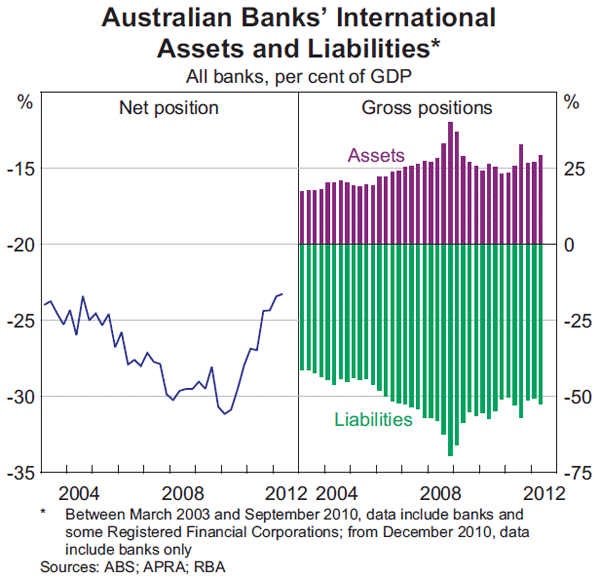
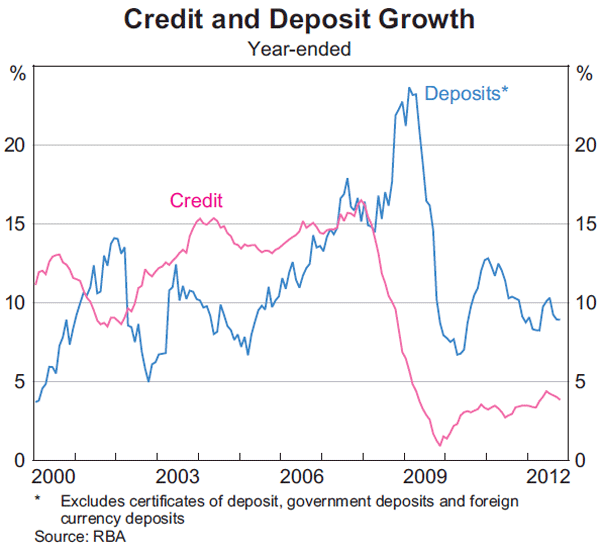
Another reason why Australian banks' net international liability position has declined is that a number of foreign-owned banks have scaled back their Australian operations, particularly some European banks that have been under pressure to deleverage in recent years (Graph 3).[4] Since peaking in 2007, the foreign-owned banks' share of domestic banking system assets has declined from over 20 per cent to a little over 10 per cent.
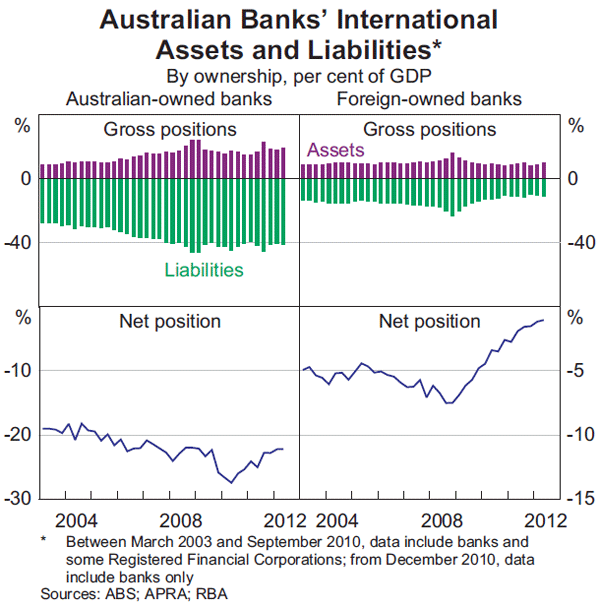
Although foreign-owned banks' international assets have declined broadly in line with the contraction of their Australian balance sheets, their international liabilities have fallen by a larger amount, largely reflecting a decline in cross-border intragroup funding. The net international liability position of foreign-owned banks in Australia has declined from 16 per cent of these banks' domestic assets in late 2008 to 4 per cent (1 per cent of GDP).
Australian-owned banks' balance sheets have continued to grow in recent years, albeit more slowly than prior to the crisis, while their net international position has been steady. As a result, their net international liability position has declined as a share of their balance sheet, from 16 per cent in mid 2010 to 13 per cent (22 per cent of GDP). The international activities of the smaller Australian-owned banks tend to be very limited. The four major banks plus Macquarie Bank account for almost all of the Australian-owned banks' gross international assets and liabilities.
The locational statistics also contain information about banks' international positions by the country of residence of their counterparties, for example, Australian banks' international assets and liabilities with UK residents. The Australian banking system has net international liability positions with the main international financial centres, particularly the United States and the United Kingdom, which together account for the bulk of the banks' total net liability position (Table 2). New Zealand is the only country where Australian banks have consistently recorded a notable net asset position. This partly reflects the funding that the head offices of the four major banks provide to their New Zealand operations. The net asset position with New Zealand has grown broadly in line with the size of New Zealand's banking system, although it increased significantly during the financial crisis (see the section on ‘Banks' International Investments’ below).
| International assets |
International liabilities |
Net international position |
|
|---|---|---|---|
| Total | 431 | 774 | −343 |
| Of which: | |||
| United Kingdom | 136 | 283 | −147 |
| United States | 63 | 216 | −153 |
| Europe (excl UK) | 58 | 60 | −2 |
| New Zealand | 27 | 7 | 20 |
| Japan | 6 | 38 | −32 |
|
(a) Gross international assets and gross international liabilities vis-à-vis the respective location Sources: APRA; RBA |
|||
Banks' International Funding
In line with the Australian banking system's role in intermediating funds from overseas savers to Australian resident borrowers, most of the banks' international liabilities are related to their funding activities in offshore markets. Debt securities and deposits account for about three-quarters of the banks' total international liabilities, the bulk of which are owed to US and UK residents (Graph 4). Australian banks typically borrow in a range of currencies to diversify their funding, and on occasion take advantage of pricing differentials, though the bulk of their international liabilities are denominated in US dollars and, to a lesser extent, Australian dollars. (The hedging of their foreign-currency liabilities is discussed below.) The share of US dollar-denominated international liabilities has increased in recent years, in part owing to a higher share of offshore bond issuance being denominated in US dollars during the crisis (including that which is government guaranteed). Conversely, the shares denominated in euros and UK pound sterling have declined.
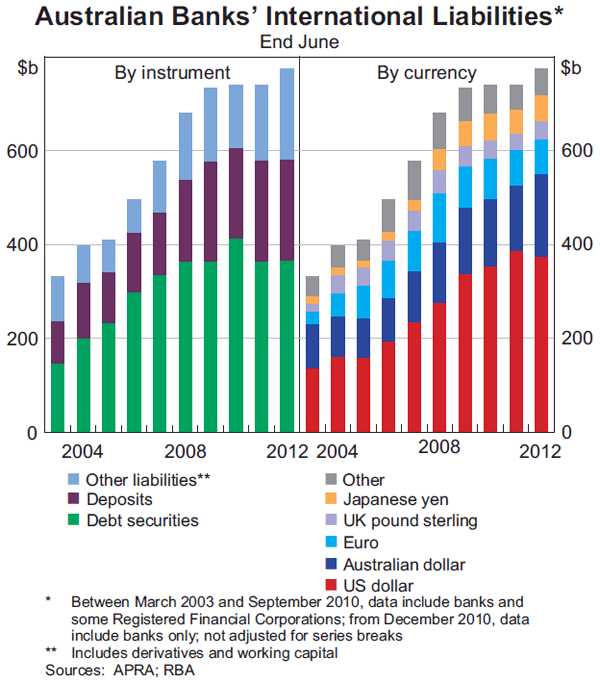
Although there can be risks in accessing any source of funds, there are a number of factors that mitigate the risks of offshore foreign-currency funding. The Australian banking system's use of international funding involves borrowing mainly in foreign currencies and lending predominantly in Australian dollars. However, the foreign currency liabilities are almost fully hedged by the banks using foreign exchange swaps, with the maturity of these hedges generally matching that of the underlying funding.[5] Australian banks, therefore, do not face material maturity mismatches in foreign currency and, unlike some European banks during the global financial crisis, do not run the same sorts of risk in having to roll over funding in a currency in which they cannot access central bank liquidity. Reflecting this hedging, the large swings in the exchange rate of the Australian dollar over recent years have not had a material effect on Australian banks' profitability, with neither losses nor gains flowing through to banks' profits from these exchange rate movements. Australian banks also generally lend to their domestic customers in Australian dollars, which means that their customers are not exposed to foreign currency risk.
Globally, banks have been responding to market and regulatory pressures to reduce their reliance on short-term wholesale funding given that it has become more expensive (relative to risk-free benchmarks) and is seen as a less stable form of funding following the experience of the crisis. The Australian banking system has also responded to this changed environment by sourcing a greater share of its funding from domestic deposits, which are generally considered to be a more stable source of funding. They have also been increasing the share of long-term wholesale debt relative to short-term wholesale debt, thereby reducing rollover risk. The modest domestic credit growth of the past few years has supported the change in banks' funding composition. The following sections look at banks' international liabilities in more detail, particularly their international debt, deposit and intragroup funding.
Developments in international debt securities and deposit funding
In the years leading up to the global financial crisis, Australian banks' international liabilities grew at a faster pace than their balance sheets. During this period, the major Australian banks raised funds domestically or in various offshore markets depending on where it was more cost-effective, even though over the longer run there was no systematic difference in issuance costs between onshore and offshore markets.[6] A benefit of issuing in offshore markets is that it provides access to a larger and more diverse investor base and banks can issue in greater volume than can typically be absorbed onshore.
During the early stages of the financial crisis, conditions in offshore debt markets became unsettled and the cost of issuing offshore increased relative to the domestic market, both in terms of wider issuance spreads and higher costs to swap foreign currency borrowings into Australian dollars. Banks responded to this by reducing their short-term issuance offshore, although this was partly offset by banks' issuance of government-guaranteed debt in offshore markets.[7]
Even though the costs of unguaranteed offshore and onshore issuance have converged, the outstanding value of Australian banks' international debt securities has been little changed over the past couple of years, and now accounts for its smallest share of funding liabilities since at least 2003 (Graph 5). Banks have not increased their use of this source of funding as they have responded to market pressures and the forthcoming Basel III liquidity regulations – global reforms that will limit the maturity mismatch between banks' assets and liabilities.
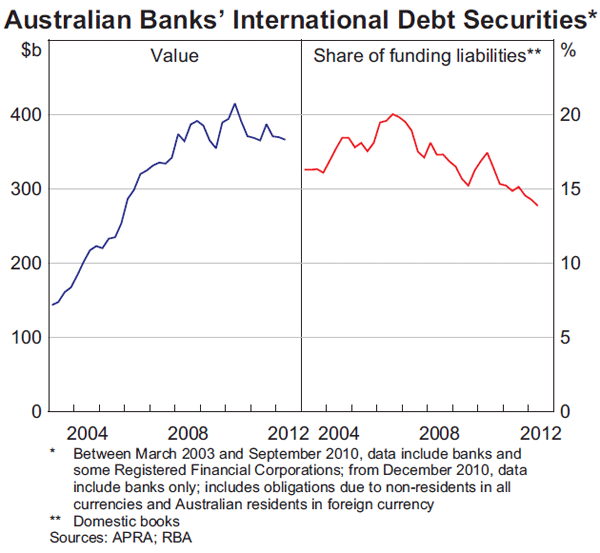
Australian banks' use of international deposit funding has grown broadly in line with their total funding liabilities over most of the past decade, although there is considerable variation in international deposit funding between Australian-owned and foreign-owned banks operating in Australia. About 6 per cent of Australian-owned banks' funding is from international deposits compared with over 25 per cent for foreign-owned banks (Graph 6). Most international deposit funding is from banks, partly in the form of intragroup funding, particularly for the foreign-owned banks (see below). Despite its name, banks' international deposit funding is likely to have characteristics that are more similar to wholesale funding than domestic deposits.
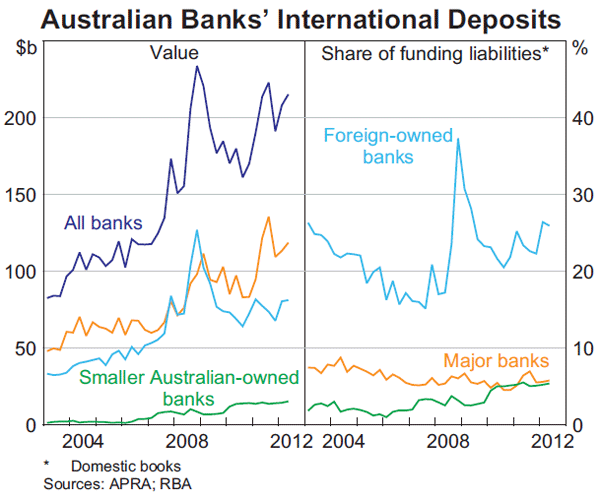
Most international deposits are denominated in either Australian or US dollars, though there is some variation in the extent of foreign currency denomination across individual banks. This is likely to be due to banks having different internal arrangements for managing the currency risk of intragroup deposits; some banks manage this risk offshore when providing funding to their Australian operations while other banks manage this risk from their offices in Australia.
Developments in international intragroup funding
Almost 20 per cent of Australian banks' international liabilities represent funding from related offshore entities (intragroup funding), with the remainder being liabilities due to unrelated entities. Roughly one-half of banks' international intragroup liabilities are comprised of deposits, with equity, working capital and derivative liabilities making up much of the rest.[8] Branches of foreign banks operating in Australia account for a disproportionate share of this offshore intragroup funding, with some of this sourced from their parent banks. Some foreign-owned banks' intragroup funding is fairly stable, but this source of funding can also be subject to large swings as branches take advantage of lending opportunities or their banking group experiences swings in funding conditions. The major Australian-owned banks source the vast bulk of their intragroup funding from the funding vehicles they operate in the major financial centres: Hong Kong, Singapore, the United Kingdom and the United States (Table 3). For example, a number of the major banks have branches in the United States that they may use to issue commercial paper and undertake other wholesale funding activities in the US market, with some of the funds being channelled back to the Australian parent as intragroup deposits. The Australian-owned and foreign-owned banks' international intragroup liabilities are typically denominated in either Australian or US dollars.
| Bank ownership(b) |
US | UK | Asian financial centres(c) |
Other | Total | Memo item: Home economy |
|---|---|---|---|---|---|---|
| Australian | 42 | 14 | 6 | 9 | 71 | na |
| North American | 6 | 12 | 1 | 2 | 21 | 7 |
| UK | 0 | 9 | 1 | 5 | 14 | 9 |
| European (excl UK) | 0 | 7 | 0 | 10 | 18 | 10 |
| Asian | 0 | 0 | 9 | 6 | 15 | 3 |
|
(a) Totals may not sum due to rounding Sources: APRA; RBA |
||||||
At the height of the financial crisis in late 2008 when some funding markets were closed, banks' international intragroup funding increased sharply, particularly that of foreign branches (Graph 7). The increase in foreign branches' funding from this source broadly offset the run-off of their domestic and offshore short-term wholesale debt. After peaking around the end of 2008, foreign branches' intragroup deposit funding declined sharply, particularly among a number of European-owned banks. Some of the pull-back by European-owned branches reflects the deleveraging pressures their parents have faced associated with the ongoing unsettled conditions in Europe. In contrast, Asian-owned branches' intragroup liabilities have been relatively stable since 2008, in part reflecting Japanese banks' limited domestic lending opportunities, which has encouraged them to lend offshore.
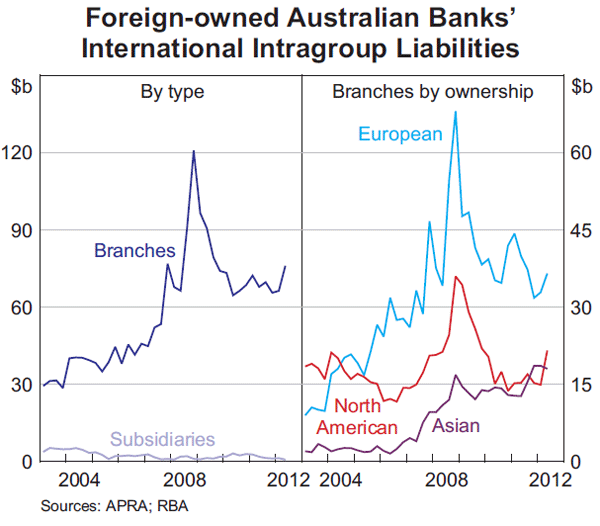
Banks' International Investments
The international assets of banks can be examined in one of two ways. The first is by looking at consolidated group assets, which account for the assets of their offshore subsidiaries and branches. For Australian-owned banks these assets are concentrated in New Zealand, the United Kingdom and the United States. The second way is to look at assets on a locational basis, which focuses attention on the positions of their Australian operations (i.e. excluding the assets of their offshore subsidiaries and branches). On a locational basis, the international assets of banks operating in Australia mainly consist of loans and other assets such as derivatives, working capital and the banks' equity investments in their foreign offices (Graph 8). In contrast to some foreign banking systems, Australian banks have relatively low holdings of international debt securities, representing less than 1 per cent of their domestic assets.
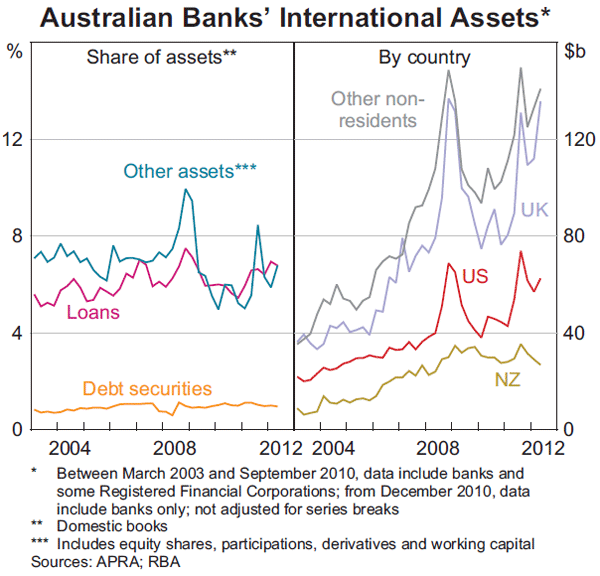
On a locational basis, part of Australian banks' international assets is the claims they have on offshore-related entities (intragroup assets). About one-third of the major banks' international assets in their key offshore markets – New Zealand, the United Kingdom and the United States – are intragroup assets. This includes various forms of funding these Australian banks provide to their offshore subsidiaries and branches, such as a loan by an Australian parent bank to its New Zealand subsidiary. In recent years, there have been increases in banks' offshore intragroup assets during periods when international debt markets have been strained. For example, offshore intragroup funding from the head offices of the four major banks increased noticeably in late 2008, particularly to their key offshore operations in New Zealand and the United Kingdom (Graph 9). While the banks' funding of their offshore subsidiaries and branches can be a channel through which shocks are transmitted from an offshore banking system to the domestic banking system, these offshore intragroup assets are relatively small as a share of the banks' domestic balance sheets, at less than 3 per cent.
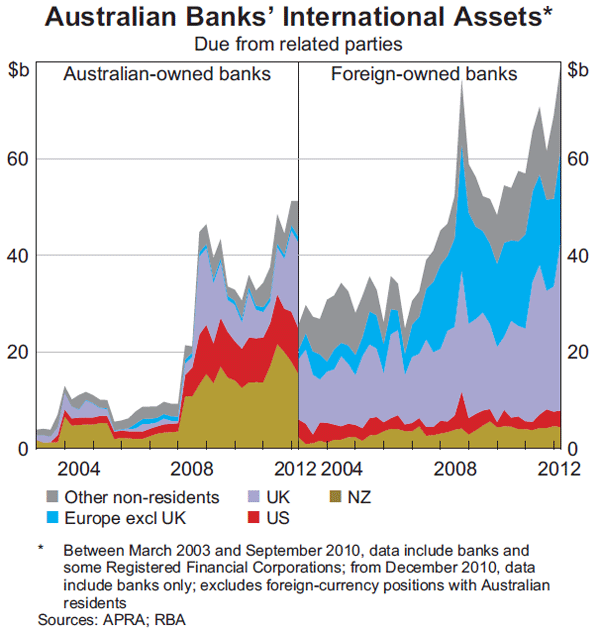
When offshore banking systems are under stress, the Australian operations of foreign banks can also fund activities in their banking group (e.g. activities of their parent bank). In late 2008, for example, the Australian operations of foreign-owned branches increased their provision of intragroup funding markedly, rising from about 10 per cent to almost 20 per cent of their domestic assets. This increase was especially pronounced for European-owned banks operating in Australia. Since the onset of the European sovereign debt crisis in 2010, the Australian operations of many European-owned banks have again increased their provision of intragroup funding sharply. In contrast, the provision of intragroup funding by foreign-owned subsidiaries during periods of stress has remained limited, accounting for a similar share of their domestic assets as for the major banks. The relatively smaller intragroup asset exposures for the major banks and foreign-owned subsidiaries reflect the prudential limits set by the Australian Prudential Regulation Authority (APRA) on locally incorporated banks' exposures.[9]
Banks' Net Intragroup Positions
The intragroup activities of Australian banks result in them being net borrowers from their offshore-related parties. While this has been the case for many years now, the structure of these international positions has changed since late 2007, particularly for foreign-owned banks. Prior to the crisis, foreign-owned banks' Australian operations were net borrowers from their wider banking groups. However, as a result of the ongoing difficulties in Europe, the gross intragroup assets and liabilities of the Australian operations of foreign-owned banks now largely offset one another. As the crisis has unfolded, euro area banks have increasingly channelled funds from their Australian operations to the wider banking groups, while North American and UK banks' offshore operations reduced the net provision of funds to their Australian operations (Graph 10). In contrast, Asian banks' net intragroup funding to their Australian operations picked up a little during the crisis, and has remained broadly unchanged over the past few years.
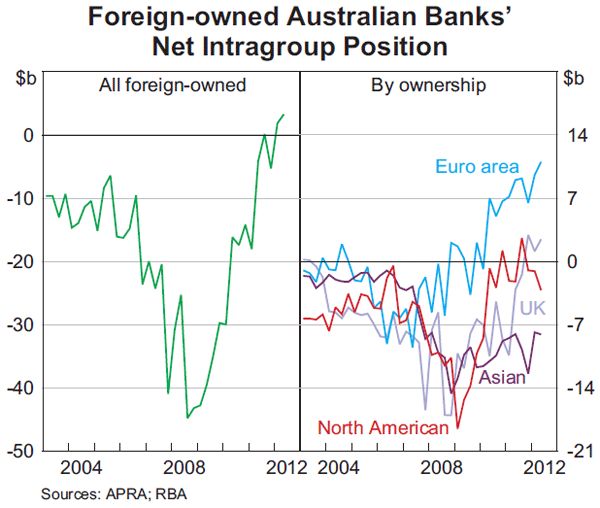
The major Australian-owned banks have continued to be net borrowers from the offshore operations of their wider banking groups, with the gross intragroup asset and liability positions both increasing in recent years. The major banks are net borrowers from their US operations – which is likely to owe to the use of their US branches as funding vehicles – and small net lenders to their New Zealand operations.
Enhancements to the IBS
The IBS enable the analysis of banks' international borrowing and investment activities and linkages within the global banking system. In response to several data gaps identified during the global financial crisis, the G-20 countries recently agreed to expand the IBS. This will be done in two phases, with APRA expected to report the initial, wider set of Australian data to the BIS by March 2013, and the second set of expanded data to be considered as part of the broader review of APRA's statistical collection currently underway. Phase one will focus on the locational banking statistics. This includes reporting of banks' entire balance sheets – banks' international positions as well as their local currency positions vis-à-vis residents. These extensions will enable better analysis of the funding risks of particular countries and the transmission of funding shocks in the event of a crisis. Phase two will focus on three key banking and financial stability issues: to better understand banks' credit exposures to particular countries and sectors; to monitor trends in the supply of cross-border and domestically sourced bank credit to the financial and non-financial sectors of individual countries; and to assess the maturity structure of banks' debt liabilities.
Another important element of the plan to enhance the IBS is improved disclosure, with national authorities being encouraged to review their confidentiality rules to make the IBS more accessible to the public. In response to this and other domestic considerations, APRA recently removed, after consultation, confidentiality rules that had previously restricted the granularity of the IBS data that was able to be published by the RBA and BIS. This expanded disclosure should enable more detailed and meaningful analysis of these data in the future.
Footnotes
The authors are from Financial Stability Department. [*]
The IBS are collected by 44 countries, including Australia, and published quarterly by the Bank for International Settlements (BIS) on its website: see <http://www.bis.org/statistics/bankstats.htm>. The IBS for Australia are collected by the Australian Prudential Regulation Authority, reported to the BIS, and published quarterly on the Reserve Bank website. For the locational data, see Statistical Tables B11.1 and B12.1 to B12.2.1 at <http://www.rba.gov.au/statistics/tables/>. [1]
For more details on the measurement of the IBS locational data, see Yuksel and Schwartz (2004). [2]
The strong competition for deposits, particularly term deposits, has seen interest rates for deposits increase noticeably relative to benchmark interest rates. For a discussion of developments in banks' funding costs and lending rates, see Deans and Stewart (2012). [3]
See RBA (2012) for a discussion of foreign-owned bank activity in Australia. [4]
For a discussion of the latest survey on foreign currency exposure and hedging in Australia, see D'Arcy, Shah ldil and Davis (2009). [5]
For an overview of banks' bond issuance and funding costs over this period, see Black, Brassil and Hack (2010). [6]
For a discussion of banks' government guaranteed offshore issuance, see Black et al (2010). [7]
Working capital is funds of a permanent debt nature provided by a bank's head office to its branch to support its day-to-day operations. [8]
Foreign-owned subsidiaries are incorporated in Australia and are subject to the same prudential standards as Australian-owned banks. In contrast, foreign-owned branches are not locally incorporated and are mainly supervised by the prudential regulator in their home country. [9]
References
Black S, A Brassil and M Hack (2010), ‘Recent Trends in Australian Banks' Bond Issuance’, RBA Bulletin, March, pp 27–33.
D'Arcy P, M Shah ldil and T Davis (2009), ‘Foreign Currency Exposure and Hedging in Australia’, RBA Bulletin, December, pp 1–10.
Deans C and C Stewart (2012), ‘Banks' Funding Costs and Lending Rates’, RBA Bulletin, March, pp 37–43.
RBA (Reserve Bank of Australia) (2012), ‘Foreign-owned Bank Activity in Australia’, Financial Stability Review, March, pp 38–40.
Yuksel M and C Schwartz (2004), ‘International Banking Statistics for Australia’, RBA Bulletin, July, pp 18–24.